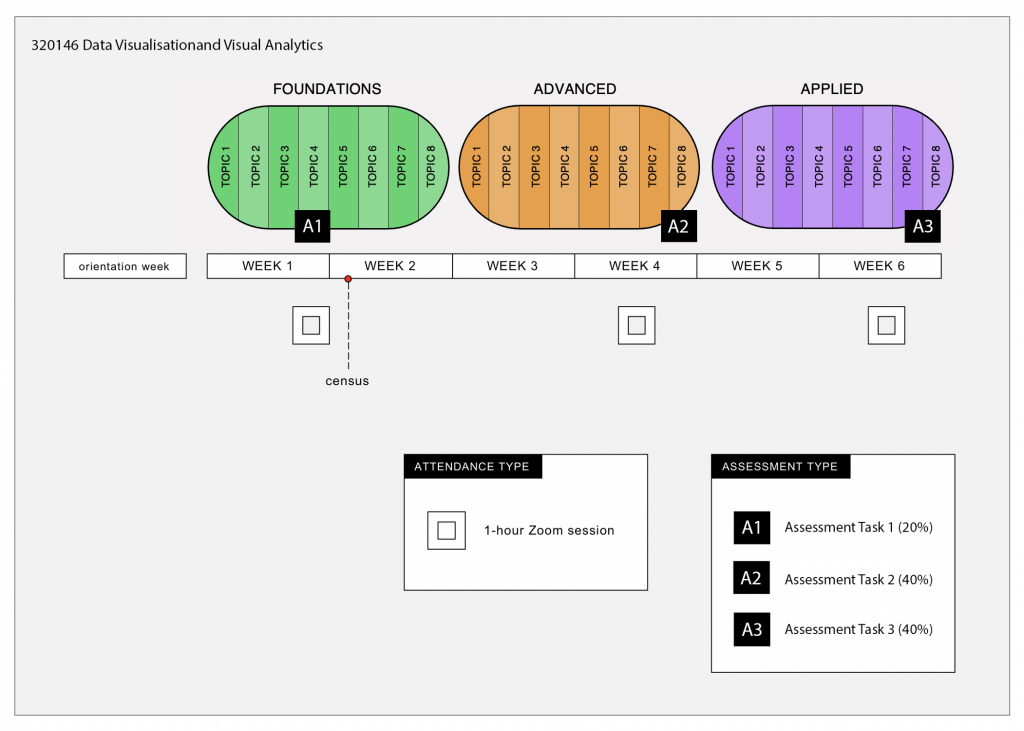With the move to Canvas, many academics took the opportunity to update and uplift their subjects. They then had to pivot their teaching to online in response to COVID-19. Now, the university is looking to expand the UTS 2027 Strategy Learning for a Lifetime offerings. This includes new business areas such as OPM (fully online in partnership) and microcredentials (standalone short forms of learning that are also a small subject in a UTS degree).
So, with all these changes and strategic objectives, how can we efficiently use our limited time and energy to expand our offerings to new audiences?
Reusing content as a sustainable solution
I’d like to present a solution that Andrew Johnston and his team from FEIT have employed. Working with learning designers from the Postgraduate Learning Design Team (PGLD), they have reused and reshaped their Data Visualisation and Visual Analytics subject content for multiple audiences.

Originally this suite of three 2cp Data visualisation microcredentials (Foundation, Advanced and Applied) was developed for an enterprise client. Each microcredential was a standalone subject delivered over 8 weeks, and learners were expected to dedicate about 5 hours a week to their learning.
A new 6cp OPM subject was on scope for development, and we were eager to reuse online teaching material that had been developed for the suite of microcredentials.

Design challenges
A condensed subject structure and shorter teaching period brought with it some design challenges.
Early in the development of the subject, it was decided that the existing teaching material in the microcredentials would be divided equally over the six weeks of teaching in the OPM subject. This meant that the subject would be divided into three modules (representing the suite of microcredentials) each now spanning two weeks of teaching.
As learning designers, it was our task to reshape the teaching material to fit this agreed modular structure. Essentially, eight weeks of part-time microcredential content now had to be delivered in two weeks to full-time students.
While this may seem like a lot of material to be covered, in a 6cp OPM subject students are expected to commit roughly twenty hours of their time to this subject per week. That commitment includes engaging with online material and resources, as well as attending any scheduled live sessions and working on their assessment tasks.

Key considerations
- Consider the impact on the subject’s assessment tasks. For example, the decision was made for students to complete their first assignment ahead of the census date at the end of week one. This had consequences on what could be assessed as students had only covered half of the foundational module at this stage.
- Think critically about how live sessions will be leveraged in the subject. For this UTS Online offering, there were only three scheduled synchronous sessions for students, compared to one per week in the existing microcredentials. As a result, many activities needed to be redesigned in order to be completed independently online.
- Finally, when migrating content there are some processes and issues to be aware of including packaging and exporting content between Canvas instances: duplicating media and interactive content to ensure analytics are tied to students in each delivery; updating all in-page references to courses, modules, weeks or assessment tasks; and making sure content is accessible for both enrolled students and learners.
To be continued…
The move from 3 micros to a 6-week OPM course isn’t the end of this reuse story. The Data Visualisation and Visual Analytics subject content is undergoing another re-model and will be delivered as a traditional 12-week subject delivered in a blended format to postgraduate IT students in the Spring semester. There are even discussions about a short course!
